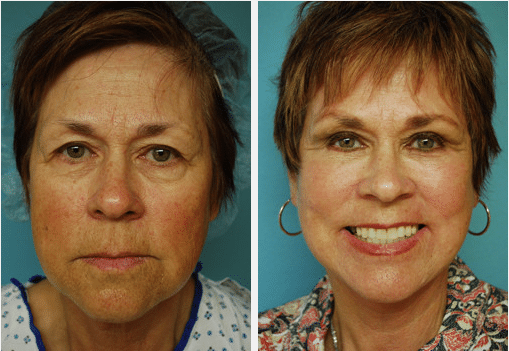Few treatments have a reputation as big as the facelift, as it is unanimously considered one of the most powerful facial rejuvenation treatments. If you’re seeking a facelift surgery, and you’re located in or around Salt Lake City, Utah, you can feel confident choosing Envision Cosmetic Surgery for your procedure.
What Is A Facelift?
A facelift, also known as a rhytidectomy, is a common surgical procedure for patients bothered by the unwanted effects of facial aging. The procedure involves tightening the skin and repositioning the muscles and fat to achieve a more youthful appearance. If you’re between 40 and 70 years old you’re a candidate. The better the skin quality and elasticity, the better results you’ll get from a facelift.
The facelift is one of the oldest cosmetic procedures; the first facelift procedure was performed in Berlin in 1901. Up until recently, where technological advances have added options, most facelifts would be called “traditional” facelifts. Today, there are various methods that Dr. Dunkley uses depending on the individual needs of each patient.

During your consultation, the two of you will discuss your goals for your facelift and you’ll discuss the various options. These are three of the common methods, although every surgery is unique to the patient.
- Traditional facelift — A traditional facelift involves the largest degree of lifting and repositioning of underlying muscle and other tissue. The goal is to rejuvenate the lower third of the face, jowls, and neck. Incisions begin at the temples on each side of the face, run down in front of the ears, wrap around the earlobes, and end in the hairline behind the ears. If the patient has extensive jowls, a second incision may be made under the chin to provide access to the skin and muscle of the upper neck. Dr. Dunkley usually doesn’t remove fat so much as he repositions it; this avoids the patient having a hollow look after recovery. Excess skin is trimmed, and then the skin is re-draped.
- Mid-face lift — In a mid-face lift, the target is the middle of the face, particularly the cheeks. Mid-face lifts can reduce puffiness under the eyes, correct nasolabial folds, and improve cheek definition and tone. For this method, Dr. Dunkley makes small incisions in the lower eyelids or the mouth.
- Limited-incision facelift — If the patient doesn’t have too much sagging, a limited-incision facelift can be effective. It provides limited rejuvenation around the eyes and mouth, including nasolabial folds and other deep creases. Shorter incisions are made at the temples, around the ears, and sometimes in the lower eyelids or under the upper lip.
What Can A Facelift Treat?
This facial plastic surgery procedure is especially recommended to eradicate visible signs of aging on the face and neck. Signs of aging include wrinkles, volume loss in the cheek area, sagging on either side of the mouth or dare we say, jowls. A facelift is the best neck treatment as well, removing loose skin under the chin and jaw to improve neck contour.
What Happens During My Facelift Consultation?
During your initial consultation with Dr. Dunkley, your goals and expectations regarding treatment are discussed. Your treatment options are presented, as are instructions on how to prepare for surgery. Your medical history, prescription medications, and past surgeries are reviewed. Dr Dunkley also performs a physical examination to assess the face.
How Can I Prepare For A Facelift?
If you’re a smoker, you’ll need to stop four weeks before and not smoke for several weeks after your surgery. Smoking decreases oxygen delivery to the operated area. Smoking can cause the skin to die. Certain medications need to be stopped a week before surgery. Certain medical conditions require a note from your regular doctor saying he feels you are okay to have surgery.
On the day of your surgery, wear loose clothing that doesn’t have to be pulled over your head. You’ll need to have someone drive you home after surgery and stay with you during initial recovery.
What Happens During A Facelift?
In a facelift, an incision is made on the hairline, starting in the temple area and continuing to the back of the ear. Once the cut is made, the skin is separated from the cheek. Dr. Dunkley accesses and tightens the underlying muscles and tissues that have caused the signs of aging to appear. Once the fat and muscle are repositioned, the skin is redraped, trimmed and closed. Various techniques are utilized based on your specific needs, preferences, and skin condition. A facelift takes from two to four hours depending on the complexity.
Are There Different Facelift Methods?
The facelift is one of the oldest cosmetic procedures on record. The first facelift procedure was performed in Berlin in 1901. A traditional facelift has changed little over the years, although recently the importance of restoring volume along with skin reduction has become apparent. Additionally, Dr. Dunkley will explain the importance of improving the skin quality with your lift as well. During your consultation, the two of you will discuss your goals for your facelift and you’ll discuss the various options. These are three of the common methods, although every surgery is unique to the patient.
- Traditional facelift — A traditional facelift involves the largest degree of lifting and repositioning of skin, fat and underlying muscle. The goal is to rejuvenate the lower third of the face, jowls, and neck. Incisions begin at the temples on each side of the face, run down in front of the ears, wrap around the earlobes, and end in the hairline behind the ears. If the patient has extensive jowls, a second incision may be made under the chin to provide access to the skin and muscle of the upper neck. Dr. Dunkley usually doesn’t remove fat so much as he repositions it; this avoids the patient having a hollow look after recovery. Excess skin is trimmed, and then the skin is re-draped.
- Mid-face lift — In a mid-face lift, the target is the middle of the face, particularly the cheeks. Mid-face lifts can reduce puffiness under the eyes, correct nasolabial folds, and improve cheek definition and tone. With the increased popularity of fat grafting to the face, fewer and fewer mediface lifts are performed.
- Limited-incision or mini facelift — If the patient doesn’t have as much sagging, a limited-incision facelift can be effective. Differenti from a traditona lift by its shorter scar, It provides limited rejuvenation around the mouth and nasolabial folds, focusing primarily on improving the jaw definition. The incision is typically only around the ears – no temple or behind the ear hairline extension.
What Happens After A Facelift?
You wear an attractive head-wrap the day of surgery. The next day an elastic dressing is put on and worn for one to three weeks. Bruising and swelling may last up to a month. As the swelling subsides, your results will become more and more noticeable. If you want to prevent others from knowing about your surgery, plan on hiding for two to three weeks. After three weeks, your friend won’t know you had surgery though they may do a double-take because you look great.
What Is Recovery Like After A Facelift?
Facelifts involve adjustments to the supporting muscles, as well as lifting and repositioning of skin. This creates tissue trauma, which shows itself as bruising and swelling. The swelling is so significant that you won’t recognize yourself for the first week. Though the pain isn’t significant the recovery is trying because of the time it takes to get back to a normal lifestyle.
Following surgery, Dr. Dunkley will have wrapped your face in bandages. A small drain tube is often placed behind the ears that is removed the next day. Your first week or so you’ll need to sleep with your head elevated, to decrease swelling. The first few days will be the most difficult. Patients note significant improvement around the one-week mark. As you recover, there will be some numb areas. Most of the swelling is gone in 2 weeks, but it still takes 2 months for most the swelling to resolve. Most patients return to work after two weeks.
Facelift Before & After Photos
How Long Does It Take To Fully Heal From A Facelift And See My Final Results?
Everyone heals differently, so it is difficult to place an exact timeframe on full recovery. Any pain has usually gone away within two weeks while the numbness takes a few months to resolve. You typically look your best 4-6 months after surgery. Sometimes it can take a full year for all swelling to resolve and sensation to return to normal. The incisions fade to white starting nine months after surgery.
How Long Do The Results Of A Facelift Last?
Initially you should focus on getting through the recovery process. Facelifts involve significant swelling so be patient as it will take a week to start seeing the results. As for how long a facelift lasts, the goal is to remove 5-10 years from your appearance. We can’t stop the aging process, collagen production continues to decrease, your skin continues to thin, and sun damage and other factors continue to add up. Hence, in 5-10 years, you may look much like you look now. However, all of these factors will start from a far younger starting point. In ten years, many of Dr Dunkley’s patients opt to have another procedure simply to keep up with continued aging.
To get started with the facelift procedure, contact us today to schedule your initial consultation with Dr. Dunkley. Envision Cosmetic Surgery offers this and other facial surgery procedures to patients in Salt Lake City, Utah, and the nearby areas of Wyoming, Idaho and Colorado.
